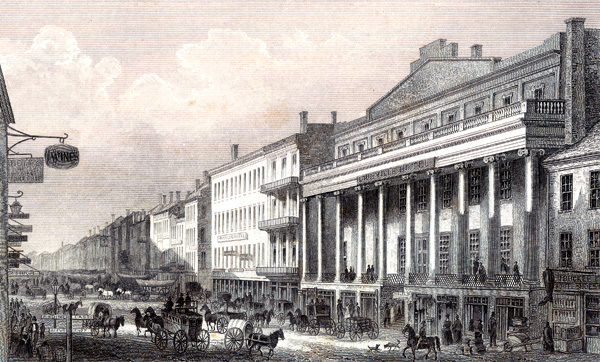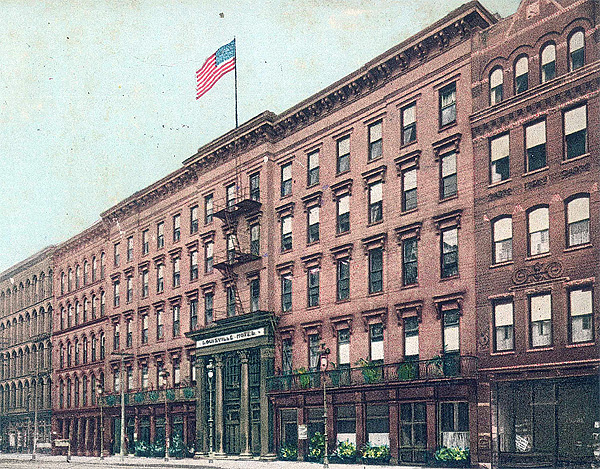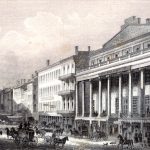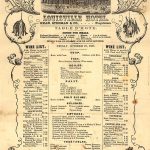
It’s always nice when a great building replaces a blank spot in the city where a once great building stood. That’s the case at 614 West Main Street where one of my favorite infill projects of the last decade, the Six Fourteen Building, complements the historic architecture of West Main Street.

The story goes back to the early 1830s when Louisville landed its first really elegant hotel, aptly named the Louisville Hotel. Completed in 1833, the structure “was a visible sign that Louisville had come of age as an urban center” (Encyclopedia of Louisville). The hotel represents a shift from “cozy inns” to modern convenience with a barber and tailor shop and a private dining room.
Designed by Louisville’s first professional architect, Hugh Roland, the four story building featured a commanding Ionic colonnade with ten columns elevated one story above Main Street (be sure to check the images after the click). Locals were proud to point out that the hotel was the most elegant in the western United States and was larger than Boston’s fashionable Tremont House.
A description of the area from a pamphlet in 1938 called “100 Years Of Public Service” reads:
Just above the newly gas-lighted waterfront was glamorous Main Street. Colorful and exciting, its hotels and amusement centers were the rendezvous for many famous characters who played leading roles in the exciting drama of city and nation-building. Here scores of gorgeously painted overland stage coaches met the fast, luxurious river boats for the South, West, East and North. Planters, astride magnificent thoroughbreds, vied with the caravans of covered wagon freighters to add exciting action. This was Louisville in 1838.

The Louisville Hotel was expanded in 1853 to Sixth Street (buildings still exist) and the colonnade was removed by architects Henry Whitestone and Isaiah Rogers. The Encyclopedia of Louisville points out that Rogers was the architect of the Tremont House. The subsequent facade resembled Boston’s hotel much more.
After losing its prominence at the turn of the century, the Louisville Hotel closed in 1938. The still existing annex had in turn served as the original Seelbach Hotel until 1905 when it moved to Fourth Street and the Old Inn. The building was razed in 1949 for a parking lot. (You may also remember another grand Louisville building was also destroyed in the 1940s.)

In the early 2000s, Fenley Real Estate built the six-story, 85,000 square foot Six Fourteen Building as office and retail space, filling a major gap in West Main Street. K. Norman Berry Associates designed the building to connect with the adjacent Doe-Anderson Building and reflect modern and historic influences in its grey brick and limestone facade.
In 2004, the Louisville Historical League designated the building as a “Future Landmark.” The vertical limestone pillars imposed on the curving glass facade could be seen as a reference to the original colonnade of the Louisville Hotel.
I included a photo of the Public Theater on Lafayette Street in Manhattan to demonstrate what the original Louisville Hotel might look like today if it were unaltered and still standing. The New York structure was built in 1832 and began as a series of townhomes called LaGrange Place and later named Colonnade Row. Today, the structure is a small theater owned by the Blue Man Group.











Just a postscript: when major league baseball’s National League was founded in 1876, those meetings are said to have taken place at the Louisville Hotel that winter. And when play began later that spring, Louisville was of course one of the charter franchises (until they were put out of the league following a betting scandal involving some of the Louisville players in 1877!). Just another reminder that our city was a very “big league” place back in those days!
Very cool. Too bad it was torn down, as so many grand buildings have been. I love the old menu. One could enjoy a Guinness even then – just 37 cents!
Great story, Mike. Louisville really must have been a bustling place 130 years ago.
I agree, Cary. The menu is great. I noticed the Guinness line as well and actually thought the price sounded a little high considering at the turn of the century a local beer went for around 5 cents a gallon. It turns out the imported beer was a real luxury back then and you would have to pay a premium to get it shipped from Ireland. The world was a much bigger place back then.
I’m confused about the line “Meals will be prompt… and no gong sounded.” What’s the reference to the gong? Anyone know?
I have not been in the 614 Main Building in quite a while, but when I use to work in advertising, the firm I worked for did the promotional material for Fenley for this property which included about 7 very large historic images of Main Street which I had to clean up and have printed with the giclee process that basically prints with special ink onto canvas. They were in the lobby the last time I was there and the images were very interesting to look at. If you happen to be near the building, I think they are worth taking a look at.
One interesting thing was that the image of the Louisville Hotel that we had included signage in one of the ground floor windows that looked like a swastika. My memory is fading on this, but it seems it was a Native American symbol. I am not sure, but I think I had photoshoped it out to avoid controversy, I will need to drop by and see again for myself.
the former life of the swastika – used to be good luck!: http://en.wikipedia.org/wiki/Swastika
Mike – Your baseball story strikes me as one of those tragicomic anecdotes about Louisville that illustrate the city’s decades-long downward spiral and a seeming acceptance of mediocrity. Why couldn’t that scandal have been overcome and a new team formed here?
I do think the city’s bland-is-fine mindset has been reversed in recent years, thank goodness, but how many times did you hear the refrains “Louisville’s not big enough” or “it’ll never fly here” or “it can’t be done” or “downtown is dead, just face it” or “we’re not New York” or something to that effect? There is a sense now that in fact it CAN be done, if people get involved enough to MAKE it happen.
Cary, not to take over Branden’s blog, but there were a few more chapters that followed the Louisvile Grays 1877 scandal. The city rejoined the major leagues again in 1882 with the formation of the American Association (at that time the country’s 2nd major professional baseball league). The Louisville Eclipse featured several stars, not the least of which was a local boy (& noted hotel lobby lounger)named Pete Browning, for whom the first “Louisville Slugger” bat was hand-crafted in 1884 by a young woodworker named Bud Hillerich, & for which the city is still known worldwide for. The first black player to play in the major leagues, Moses Fleetwood Walker, made his debut in Louisville that year, too, as a member of the Toledo club. The Eclipse had the dubious distinction of going from last place in 1889 to win their first pennant in 1890, & played the Brooklyn Bridegrooms of the National League in the fall of ’90 in a best-of-9 “world series.” Alas, more tragi-comedy here: the series was suspended tied at 3 games apiece by a rare fall blizzard in Brooklyn & never resumed, so the “Cyclones” (the team’s nickname that year from a horrific tornado that had struck the city in March) could rightfully claim to be baseball’s world co-champions. It was a season that began & ended with a “wind,” I suppose! The team returned to the National League for the remainder of the 90’s before losing records, poor attendance & a fire that destroyed their ballpark sent the team’s remaining players up the river to Pittsburgh in a merger of the 2 franchises after the 1899 season. Honus Wagner, the famed shortstop whose baseball card is still worth a hefty sum today, was among those players. Barney Dreyfus, the team’s last owner, was recently inducted into the baseball Hall of Fame. And of course, the city’s 20th century baseball history, though minor league, is filled with notable chapters as well (i.e., Pee Wee Reese, the Redbirds drawing 1 million fans in a season).
So even if we’re building an arena now that Branden thinks looks like a big whale, perhaps like Capt. Ahab, Louisville has always chased those big league dreams like a mythical great white whale (and maybe this new arena will finally help our city be “big league” again in another sport).
By the way, Branden, maybe an article on Louisville’s baseball parks would make an interesting read for us urban-philes sometime. Profesional baseball has been played in several venues around the city for almost 140 years, & there are subtle reminders of those edifices scattered around the landscape (see “Baseball Alley” & “Parkway Field” for a few hints; in fact, Eastern Parkway today has that slight curve in it near U of L Speed School because the original parkway had to be relocated in 1923 to accomodate the left field wall at the stadium being built for the Colonels back then).
Anyway, sorry for the tangent into local baseball history!
I have a sugar bowl mark louisville hotel, made by the gorman company, the date it was made was 1858 could be the only thing left of the hotel
Just picked up a silver soldered bowl “something” by Gorham-2 handled with Louisville Hotel engraved on bottom with anchor and a rooster. It is 3 inches deep. Love it-any ideas? Enjoyed the article and pix! Thanks! KJm
Brandon,
Not sure if this is still active or not, but I found a baggage tag with the hotel name stamped on it. If you’d like a picture, let me know and I’ll send you one.